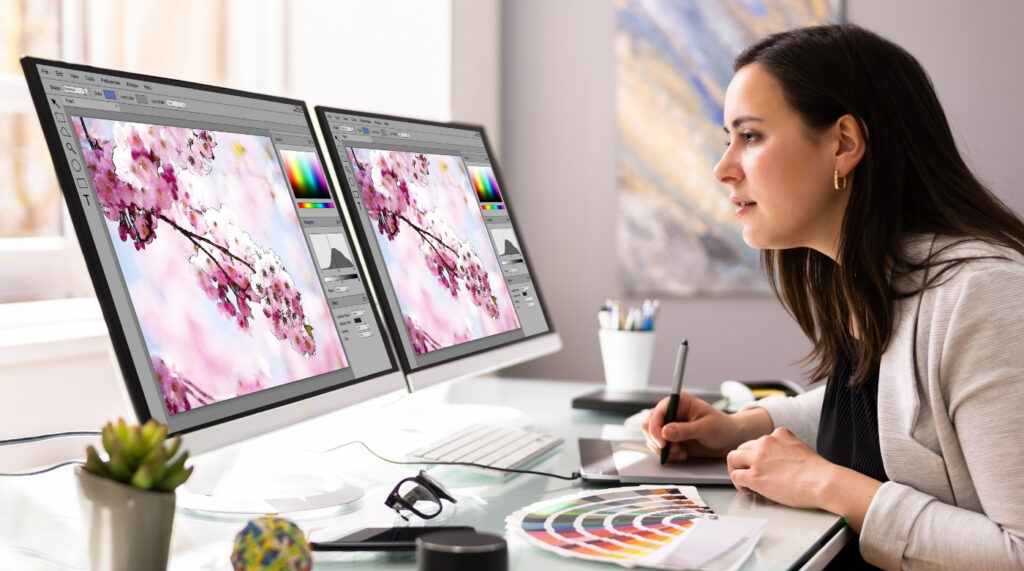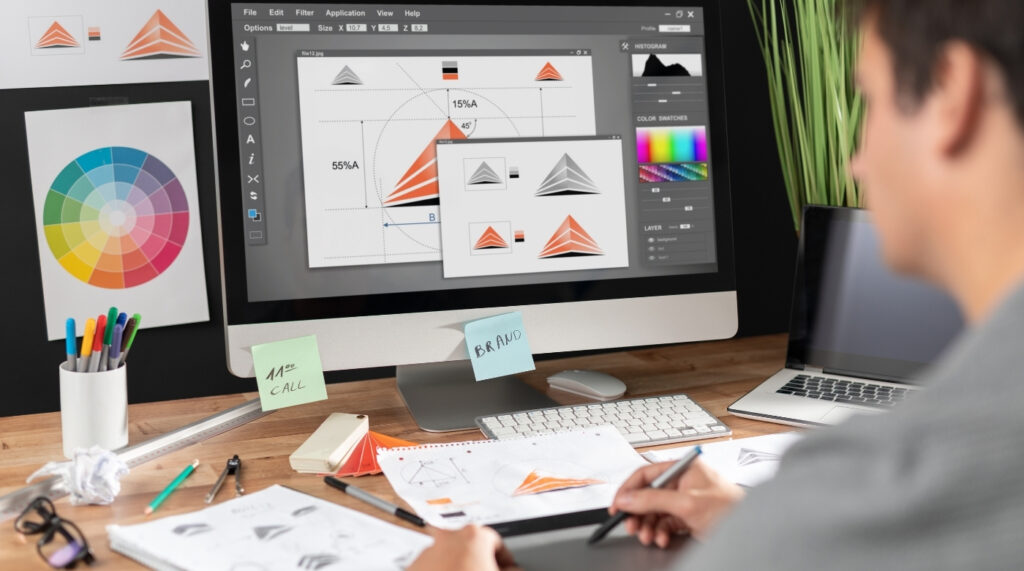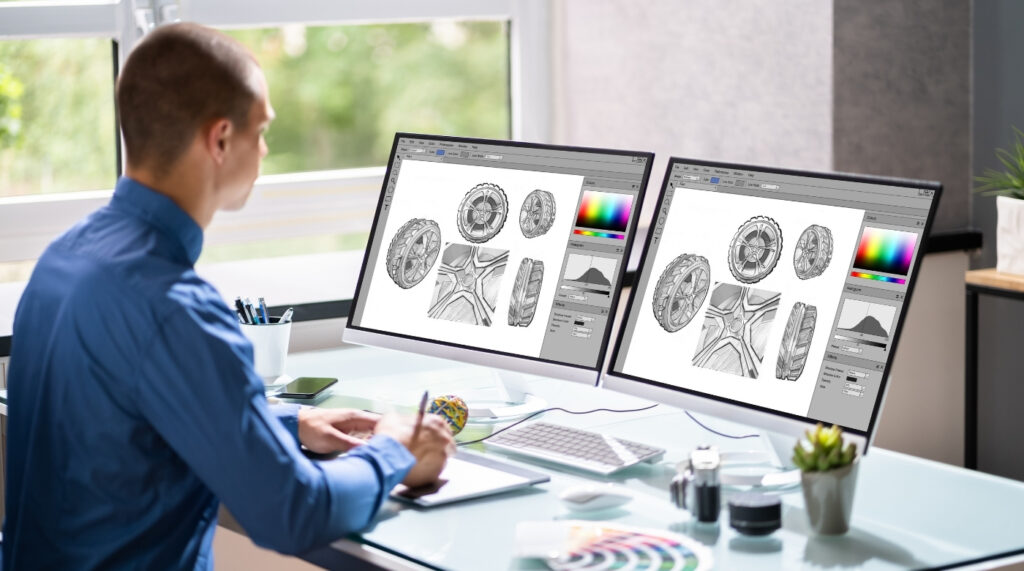Graphic design has always been about much more than colours, logos, or typefaces. It is a powerful form of communication that brings ideas to life, influences decisions, and shapes culture. Today, graphic design careers are more dynamic than ever, blending traditional skills with cutting-edge technology and expanding into areas such as digital illustration, web design, and animation.
With the rapid growth of creative industries and the increasing demand for visually engaging content, pursuing a career in graphic design offers exciting opportunities for artistic individuals with a flair for problem-solving. This career guide explores how to build a future in graphic design, the qualifications needed, salary expectations, progression routes, and the diverse specialisations available.
Why Choose a Career in Graphic Design?
Graphic design professionals are at the heart of the digital and creative economy. Every brand, organisation, and business requires visual storytelling, from advertising campaigns to website interfaces. As more of life moves online, the demand for skilled designers continues to grow.
The career offers freedom of expression, the opportunity to work across multiple industries, and the chance to create work that influences millions of people. Unlike some professions that may feel routine, graphic design offers constant variety. One day may be focused on designing user-friendly websites, the next on producing an animated advertisement or developing digital illustrations for a campaign.
Another appeal is flexibility. Many designers choose freelance or remote work, while others thrive within agencies or in-house creative teams. This flexibility allows individuals to build careers that align with their lifestyle and personal interests.

The Expanding Role of Graphic Design
The traditional role of a graphic designer as someone who produces print layouts has transformed dramatically. Today, designers need to be skilled in multiple disciplines. Digital illustration is now essential for visual storytelling, whether for social media, online campaigns, or brand identity. Web design is a critical part of the role, ensuring that digital platforms not only look appealing but also function seamlessly. Animation is another growing area, bringing static designs to life and creating immersive digital experiences.
This shift has made graphic design one of the most interdisciplinary career paths available. Professionals often work with marketing teams, developers, content creators, and strategists. The integration of creativity with technology ensures that design careers remain both challenging and rewarding.
Qualifications for Graphic Design Careers
The qualifications needed to enter the field vary depending on the type of role and career aspirations. Some employers require degree-level education, while others value portfolios and practical experience above formal qualifications. Below is a guide to the most common routes.
- Entry-Level Qualifications: Certificates or diplomas in art and design; short courses in software such as Adobe Creative Cloud; vocational courses in digital illustration or web design.
- Degree-Level Qualifications: Bachelor’s degrees in graphic design, visual communication, web design, digital media, or animation.
- Postgraduate Qualifications: Master’s degrees in design management, motion graphics, interactive design, or advanced digital illustration.
These qualifications are often combined with real-world projects and internships, as portfolios remain the most powerful way to demonstrate skills in the industry.
Salary Expectations in Graphic Design
Salaries in graphic design vary depending on specialisation, experience, and the type of employer.
| Role | Starting Salary | Experienced Salary | Senior Salary |
|---|---|---|---|
| Junior Graphic Designer | £20,000 | £28,000 | £35,000+ |
| Web Designer | £22,000 | £32,000 | £45,000+ |
| Digital Illustrator | £21,000 | £30,000 | £40,000+ |
| Animator/Motion Designer | £24,000 | £35,000 | £50,000+ |
| Creative Director | £40,000 | £60,000 | £80,000+ |
Freelancers often set their own rates and can sometimes surpass salaried positions, particularly if they work with international clients or specialise in high-demand areas such as animation and advanced web design.
Skills Required for Success
While qualifications open doors, success in graphic design depends heavily on skills that combine creativity with technical ability. A strong sense of visual storytelling, the ability to translate ideas into engaging imagery, and confidence in using digital tools are essential.
For those working in digital illustration, precision and creativity are equally important, with many professionals needing to balance client briefs with artistic flair. Web design requires both an eye for aesthetics and a functional understanding of user experience, ensuring that websites are not just visually appealing but easy to navigate. Animation demands technical proficiency in motion software as well as an understanding of timing, rhythm, and storytelling.
Soft skills also matter. Designers must collaborate with marketing teams, clients, and developers, which requires communication, adaptability, and problem-solving. Meeting deadlines under pressure is a common aspect of the profession, and resilience is key to handling constructive criticism while maintaining creativity.
Career Roadmap for Graphic Designers
A typical pathway in graphic design careers begins with learning the fundamentals of design, either through formal education or self-study, followed by building a portfolio and gaining professional experience.
| Career Stage | Training/Experience | Typical Roles | Progression Opportunities |
|---|---|---|---|
| Beginner | Certificates/Diplomas | Junior Graphic Designer, Assistant Illustrator | Mid-level designer, freelance roles |
| Intermediate | Degree-level qualifications | Graphic Designer, Web Designer, Animator | Senior designer, creative lead |
| Advanced | Postgraduate qualifications | Senior Animator, Lead Illustrator, UX Designer | Creative Director, Consultant |
This roadmap shows that the career is not rigid. Many designers start freelancing early, while others spend years in agencies before moving into leadership roles. Flexibility is one of the strengths of the profession, allowing individuals to adapt their journey to personal goals.
Statistics on Graphic Design Careers
The creative industries contribute billions annually to the economy, with graphic design forming a substantial part of this growth. Recent reports show a steady increase in demand for professionals with web design and animation skills, as more companies prioritise digital experiences.
Data also indicates that social media has become one of the largest drivers of employment in digital illustration. Brands increasingly rely on unique illustrations to stand out in saturated markets. Animation is also on the rise, particularly in advertising and entertainment, where short-form video and interactive media dominate consumer attention.
According to labour market projections, design-related roles are expected to grow by more than 15% over the next decade, with the highest demand in web design, animation, and UX/UI integration. This aligns with global digitalisation trends, ensuring strong long-term prospects for those entering the profession.

Specialisations in Graphic Design
One of the most exciting aspects of graphic design is the ability to specialise in a chosen discipline. Digital illustration offers opportunities to work in publishing, advertising, and entertainment. Illustrators may design book covers, produce branded graphics, or develop concept art for games and films.
Web design, meanwhile, is central to the digital economy. Designers create layouts, visual elements, and user experiences that make websites functional and engaging. The rise of e-commerce and digital-first businesses has significantly increased demand for skilled web designers.
Animation offers some of the most creative opportunities, spanning film, advertising, online content, and gaming. Motion design in particular has become a key marketing tool, with animated graphics dominating social media campaigns and online advertising strategies.
Work Environments for Graphic Designers
Graphic design careers can be found in a variety of environments. Many work within design agencies, producing content for multiple clients across industries. Others are employed directly by companies, serving as part of in-house marketing or creative teams. Freelancing remains popular, giving professionals independence and the ability to choose projects.
The digital age has also opened global opportunities. Designers can collaborate with international clients from anywhere in the world, often working remotely. This flexibility allows individuals to balance work and lifestyle in ways not possible in more traditional careers.
The Future of Graphic Design Careers
The outlook for graphic design is vibrant. As businesses invest more heavily in online presence, the demand for web design and animation continues to grow. The rise of augmented reality and virtual reality also presents new opportunities for designers, requiring fresh approaches to digital illustration and animation.
Another emerging trend is the integration of artificial intelligence into design workflows. While AI can automate some tasks, it is also expanding the creative possibilities for designers, offering new tools to experiment with. Far from replacing professionals, technology is enhancing their ability to innovate and deliver cutting-edge solutions.
The increasing importance of brand storytelling ensures that graphic design remains at the centre of marketing, media, and digital culture. For creative individuals willing to adapt and expand their skills, the future of the profession is filled with opportunity.
Final Thoughts
Graphic design is more than a career—it is a chance to shape how the world sees, feels, and interacts with information. Whether your passion lies in digital illustration, web design, or animation, the pathways are rich with opportunities for growth, creativity, and impact.
The qualifications provide clear entry points, but it is skills, creativity, and adaptability that drive long-term success. Salaries offer stability, progression routes are diverse, and the growing importance of digital content ensures that graphic design will remain one of the most in-demand creative professions for years to come.
For those ready to turn creativity into a career, graphic design offers not just a job but an exciting, evolving journey.

